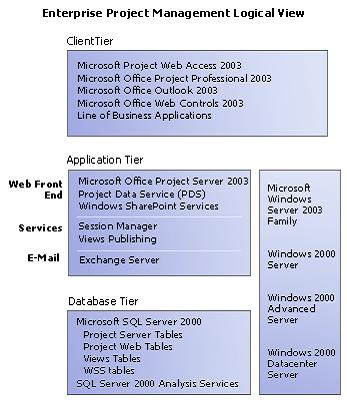In today's competitive world, where every IT manager is being asked by their Executive Teams to do more with less, project management and project portfolio management are becoming more and more crucial. The need to be able to review a complete portfolio of projects to be certain the maximum value is being driven to the bottom line along with the need to balance the company's finite set of resources has many firms defining an enterprise project management (EPM) strategy and implementing tools to support that strategy.
So, of course, several vendors have rushed to provide tools to fill this need. With each of these products, there are positives and negatives; in this article, we will take a look at Project Server 2003, the backbone of the Microsoft Office EPM. Project Server works with other core and enabling technologies to complete the EPM solution, which we'll look at more closely in a moment. This is Microsoft's second major release of the product as the company continues to evolve it and the Office EPM solution.
Feature Stack
So what functionality do Project Server and the Office EPM solution bring to the enterprise? Project Server provides you with a Web client that can be accessible to everyone in your organization--whether you are in one locale or distributed geographically. The Web client provides access for both administrators of Project Server and everyone from executives to project managers to team members. With this Web-based client, you can perform enterprise resource management, time reporting and status reporting, viewing of project health and portfolio health, portfolio analysis and modeling using OLAP data cubes, issue tracking, risk management, and document management. Project Server also allows for customization and integration with custom-built line-of-business systems.
As I mentioned, Project Server acts as the backbone to the Office EPM solution, but it cannot work on its own. One other product that is core to this solution is Microsoft Office Project Professional 2003. This is the desktop client that a lot of us are familiar with today and use in our project planning and management. Project Professional is necessary to build your project plans and resource assignments and then store this information in a database for Project Server to access.
This long list of features and functionality looks impressive, but you must understand that in order to take advantage of everything that Project Server and the Office EPM solution have to offer, other base and enabling technologies must be in place. In order to build the EPM feature stack, you must start with the Microsoft Windows Server platform and Microsoft SQL Server 2000. The Web-based front-end takes advantage of IIS as the Web server and Windows SharePoint Services to provide the issue tracking, risk management, and document management pieces. Also, any users who wish to do portfolio analysis will need Office Web Controls installed. These are only available as part of the Office 2003 implementation.
Solution Architecture
We've discussed the features that Project Server and the Office EPM have to offer, but how does this technology stack look? Figure 1 is a logical view of the Office EPM architecture. This figure is from the Project Server 2003 Configuration Planning Guide.

Figure 1: This is a logical view of the Office EPM architecture. (Click image to enlarge.)
Project Server is architected to be a scalable, Web-based server application. The data for your projects is stored in SQL Server 2000 in a number of predefined tables and views. The Project database is a set of tables that stores the operational data for Project Server. All enterprise data is stored here, including all versions of each project. The Views database is a read-only database that contains data from the Project database that is readied for report generation and different Web views. If you wish to use the Portfolio Analyzer feature in Project Server 2003, then SQL Server 2000 Analysis Services is required. The Analysis Services set of tools aids in the building and maintaining of OLAP cubes for analysis purposes.
The Application Tier provides the Project Data Service (PDS), which is a set of Web services that is the entry point for any application integration. This set of services allows you to integrate custom line-of-business applications, and it ensures that the data being used by Project Server stays consistent.
I won't take the time in this article to describe each piece of each tier, but I think this gives you a fairly good idea of how the Project Server/Office EPM solution has been constructed. The figure also allows you to see the number of Microsoft products that are built to integrate with Project Server or can be used to extend its functionality.
Implementation
How do you go about implementing what we've seen? When looking to implement Project Server as part of your EPM solution, the first step has to be planning--that is, analyzing your needs from a project or portfolio management standpoint and designing your solution around that. One of the biggest challenges that I've seen with a product like Project Server is that folks who run project management solutions are so excited about the possibilities with the rich feature set that they don't stop to ask how project management is done and what really applies to them. One of the worst things that can happen, and does, is that the person in charge of implementing Project Server implements all the feature functionality and has the necessary infrastructure built to support it, but when it is rolled out to the masses, it is either too complex and confusing to use or people end up using only a tiny fraction of the functionality. So realistic requirements analysis is a key to success.
When you begin your planning, look at the number and types of users who will be accessing the system, the types of projects that this will support, the volume of projects to be supported, the number of different roles defined in your projects, the features of Project Server that your organization truly requires, and the environment you plan to deploy Project Server in. Spend time with your organization's project managers and executives to understand what information they need in order to manage projects and the portfolio of projects better. Also, make sure you include your firm's system administrators, network engineers, database administrators, and any application interface developers in your planning sessions.
As mentioned, it is important to determine the types of users that you will need to support because Project Server and the Office EPM solution provide different tools for the different roles people play. A project manager, for example, would need access to both Project Server and Project Professional to build and maintain plans, assign resources to tasks, track and report on project status, and determine and track timelines and budgets. A team member, though, would need access only to the Project Server Web client to view assigned tasks, submit time and status reports, and log any issues that might arise. An executive might want to use Web access to forecast using Portfolio Modeler, view project and resource reports, and communicate issues with project and resource managers.
Things to Consider
I recommend that you be careful with all the features that this product has to offer; it has been my experience that the more features you implement, the more complex it becomes from an administration and usability standpoint. Also, keep in mind that this product does work well in Microsoft environments, but if you are not currently running any Microsoft platforms, be wary of infrastructure costs to get up and running. The ROI may very well be there for you to add the Microsoft platforms; I simply recommend you do your homework in this area.
Though this article only touches on Microsoft Office Project Server 2003 and the Office EPM solution, I hope it gives you some insight into what this product can provide if you take the time to understand your firm's project management needs and the ways your staff would work with the tool set. This product provides outstanding features that integrate well in environments that currently have Microsoft platforms in place.
Dale Mittelstaedt is the Microsoft Technologies Practice Director for New Resources Consulting in Milwaukee, Wisconsin. He has been in the IT industry for 13 years as a management consultant and IT director. He can be reached at




















 More than ever, there is a demand for IT to deliver innovation. Your IBM i has been an essential part of your business operations for years. However, your organization may struggle to maintain the current system and implement new projects. The thousands of customers we've worked with and surveyed state that expectations regarding the digital footprint and vision of the company are not aligned with the current IT environment.
More than ever, there is a demand for IT to deliver innovation. Your IBM i has been an essential part of your business operations for years. However, your organization may struggle to maintain the current system and implement new projects. The thousands of customers we've worked with and surveyed state that expectations regarding the digital footprint and vision of the company are not aligned with the current IT environment. TRY the one package that solves all your document design and printing challenges on all your platforms. Produce bar code labels, electronic forms, ad hoc reports, and RFID tags – without programming! MarkMagic is the only document design and print solution that combines report writing, WYSIWYG label and forms design, and conditional printing in one integrated product. Make sure your data survives when catastrophe hits. Request your trial now! Request Now.
TRY the one package that solves all your document design and printing challenges on all your platforms. Produce bar code labels, electronic forms, ad hoc reports, and RFID tags – without programming! MarkMagic is the only document design and print solution that combines report writing, WYSIWYG label and forms design, and conditional printing in one integrated product. Make sure your data survives when catastrophe hits. Request your trial now! Request Now. Forms of ransomware has been around for over 30 years, and with more and more organizations suffering attacks each year, it continues to endure. What has made ransomware such a durable threat and what is the best way to combat it? In order to prevent ransomware, organizations must first understand how it works.
Forms of ransomware has been around for over 30 years, and with more and more organizations suffering attacks each year, it continues to endure. What has made ransomware such a durable threat and what is the best way to combat it? In order to prevent ransomware, organizations must first understand how it works. Disaster protection is vital to every business. Yet, it often consists of patched together procedures that are prone to error. From automatic backups to data encryption to media management, Robot automates the routine (yet often complex) tasks of iSeries backup and recovery, saving you time and money and making the process safer and more reliable. Automate your backups with the Robot Backup and Recovery Solution. Key features include:
Disaster protection is vital to every business. Yet, it often consists of patched together procedures that are prone to error. From automatic backups to data encryption to media management, Robot automates the routine (yet often complex) tasks of iSeries backup and recovery, saving you time and money and making the process safer and more reliable. Automate your backups with the Robot Backup and Recovery Solution. Key features include: Business users want new applications now. Market and regulatory pressures require faster application updates and delivery into production. Your IBM i developers may be approaching retirement, and you see no sure way to fill their positions with experienced developers. In addition, you may be caught between maintaining your existing applications and the uncertainty of moving to something new.
Business users want new applications now. Market and regulatory pressures require faster application updates and delivery into production. Your IBM i developers may be approaching retirement, and you see no sure way to fill their positions with experienced developers. In addition, you may be caught between maintaining your existing applications and the uncertainty of moving to something new. IT managers hoping to find new IBM i talent are discovering that the pool of experienced RPG programmers and operators or administrators with intimate knowledge of the operating system and the applications that run on it is small. This begs the question: How will you manage the platform that supports such a big part of your business? This guide offers strategies and software suggestions to help you plan IT staffing and resources and smooth the transition after your AS/400 talent retires. Read on to learn:
IT managers hoping to find new IBM i talent are discovering that the pool of experienced RPG programmers and operators or administrators with intimate knowledge of the operating system and the applications that run on it is small. This begs the question: How will you manage the platform that supports such a big part of your business? This guide offers strategies and software suggestions to help you plan IT staffing and resources and smooth the transition after your AS/400 talent retires. Read on to learn:
LATEST COMMENTS
MC Press Online